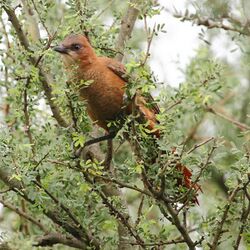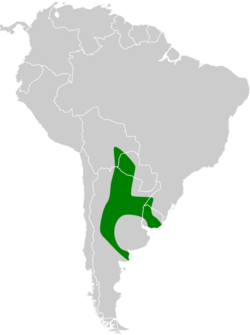Biology:Brown cacholote
| Brown cacholote | |
|---|---|

| |
| At Santa Fe Province, Argentina | |
| Scientific classification | |
| Domain: | Eukaryota |
| Kingdom: | Animalia |
| Phylum: | Chordata |
| Class: | Aves |
| Order: | Passeriformes |
| Family: | Furnariidae |
| Genus: | Pseudoseisura |
| Species: | P. lophotes
|
| Binomial name | |
| Pseudoseisura lophotes (Reichenbach, 1853)
| |

| |
The brown cacholote (Pseudoseisura lophotes) is a species of bird in the Furnariinae subfamily of the ovenbird family Furnariidae. It is found in Argentina , Bolivia, Brazil , Paraguay, and Uruguay.[2]
Taxonomy and systematics
The brown cacholote's taxonomy is unsettled. The International Ornithological Committee and BirdLife International's Handbook of the Birds of the World assign it two subspecies, the nominate P. l. lophotes (Reichenbach, 1853) and P. l. argentina (Parkes, 1960).[2][3] The Clements taxonomy does not recognize P. l. argentina, treating the brown cacholote as monotypic.[4]
This article follows the two-subspecies model.
Description
The brown cacholote is 24 to 26 cm (9.4 to 10 in) long and weighs 63 to 79 g (2.2 to 2.8 oz). It is one of the largest furnariids and with its prominent crest somewhat resembles a jay. The sexes have the same plumage. Adults of the nominate subspecies have a dark rufous face. Their forehead is dark reddish brown and their crown and crest darker brown with a streaked look. Their hindcrown is bright rufous, their "collar" and upper back duller rufous, the rest of their back even duller rufous, their rump bright rufous, and their uppertail coverts a darker rufous. Their wing coverts are dark rufous-brown with paler feather tips and their flight feathers dark fuscous brown with narrow pale brownish edges. Their tail is dark rufous; the feathers have few barbs on their ends. Their throat is bright cinnamon-rufous. Their breast and upper belly are darker with pale feather tips on the latter. Their lower belly, flanks, and undertail coverts are more rufescent with the same "frosty" pattern of pale feather tips. Their iris is yellow to buff-yellow, their maxilla black with a gray base, their mandible blackish with a light gray base, and their legs and feet grayish olive to dull greenish. Juveniles have a shorter crest than adults, with some mottling on the underparts and a greenish iris. Subspecies P. l. argentina is overall darker than the nominate, with the front of its crest more rufous.[5]
Distribution and habitat
The nominate subspecies of the brown cacholote is found in southern Bolivia and western Paraguay. Subspecies P. l. argentina is found in northern and central Argentina, far southern Brazil, and Uruguay. The species inhabits tropical deciduous forest, the edges of gallery forest, chaco woodlands and scrublands, and parks and gardens in urban areas. In elevation it ranges from near sea level to 900 m (3,000 ft).[2][5][6]
Behavior
Movement
The brown cacholote is a year-round resident throughout its range.[5]
Feeding
The brown cacholote feeds primarily on arthropods but also includes eggs of other birds, seeds, and fruit in its diet. It usually forages in pairs or with other brown cacholotes. It feeds mostly on the ground, gleaning, probing, and digging in soil and leaf litter. It has also been observed flaking dung and hammering and pulling on bark and leaf buds.[5]
Breeding
The brown cacholote breeds in the austral spring and summer; eggs have been noted between September and February. It is monogamous and is thought to mate for life. Its nest is a mass of sticks about half again as long as it is wide with an entrance tube on its side and an inner chamber that is sometimes lined with smaller and softer material. It is supported by and partially incorporates a tree branch, typically about 4 to 6 m (10 to 20 ft) above the ground. The clutch size is two to four eggs. The incubation period is 18 to 20 days and fledging occurs 18 to 23 days after hatch. Both adults incubate the clutch and brood and provision nestlings.[5]
Vocalization
The brown cacholote's song is an "[u]musical duet of well-spaced, grating notes, intermixed with soft, descending 'tjew' notes".[6] Its call is "krok".[5]
Status
The IUCN has assessed the brown cacholote as being of Least Concern. It has large range and an unknown population size that is believed to be decreasing. No immediate threats have been identified.[1] It is considered uncommon to fairly common and occurs in several protected areas.[5]
References
- ↑ 1.0 1.1 BirdLife International (2018). "Brown Cacholote Pseudoseisura lophotes". IUCN Red List of Threatened Species 2018: e.T22702740A130276118. doi:10.2305/IUCN.UK.2018-2.RLTS.T22702740A130276118.en. https://www.iucnredlist.org/species/22702740/130276118. Retrieved 19 November 2023.
- ↑ 2.0 2.1 2.2 Gill, Frank; Donsker, David; Rasmussen, Pamela, eds (July 2023). "Ovenbirds, woodcreepers". https://www.worldbirdnames.org/new/bow/ovenbirds/.
- ↑ HBW and BirdLife International (2022) Handbook of the Birds of the World and BirdLife International digital checklist of the birds of the world. Version 7. Available at: https://datazone.birdlife.org/userfiles/file/Species/Taxonomy/HBW-BirdLife_Checklist_v7_Dec22.zip retrieved December 13, 2022
- ↑ Clements, J. F., P.C. Rasmussen, T. S. Schulenberg, M. J. Iliff, T. A. Fredericks, J. A. Gerbracht, D. Lepage, A. Spencer, S. M. Billerman, B. L. Sullivan, and C. L. Wood. 2023. The eBird/Clements checklist of birds of the world: v2023. Downloaded from https://www.birds.cornell.edu/clementschecklist/download/ retrieved October 28, 2023
- ↑ 5.0 5.1 5.2 5.3 5.4 5.5 5.6 Remsen, Jr., J. V. (2020). Brown Cacholote (Pseudoseisura lophotes), version 1.0. In Birds of the World (J. del Hoyo, A. Elliott, J. Sargatal, D. A. Christie, and E. de Juana, Editors). Cornell Lab of Ornithology, Ithaca, NY, USA. https://doi.org/10.2173/bow.brncac1.01 retrieved November 19, 2023
- ↑ 6.0 6.1 van Perlo, Ber (2009). A Field Guide to the Birds of Brazil. New York: Oxford University Press. pp. 222. ISBN 978-0-19-530155-7.
Wikidata ☰ Q1274815 entry
 |


